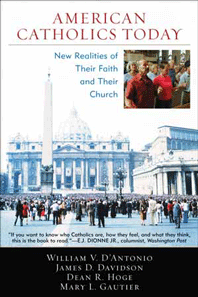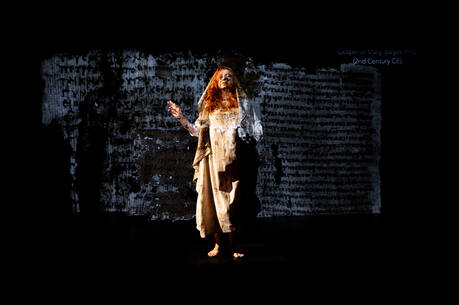Everyone seems interested these days in defining Catholic identity—movements and Movements, R.C.I.A. and Neocatechumenate, liturgists and “religious” educators, curial vigilantes and the rear-guard of “social actionists.” No one wonders how the Catholic laity define their Catholic identity. Then Professor Dean Hoge of the Catholic University of America had a brilliant idea. Let’s ask them.
Professor Hoge composed a list of 12 “elements” of Catholicism and asked how important each was (ranging from “very important” to “not too important at all”). The elements ran from “helping the poor” to “celibate male clergy” and included such matters as “devotion to Mary the Mother of Jesus” and “teachings in opposition to abortion.” These findings are gathered in his new book, American Catholics Today.
The merit of this scale is that it permits respondents to choose those aspects of the Catholic heritage that are the most important to them that tie them most deeply to the church, that are the glue that holds everything else together, that they would never give up. The scale has been used in different forms and in different countries (Msgr. Conor Ward and I administered it in Ireland as part of the Irish participation in the International Social Survey Program). It is mostly invariant across demographic variables.
While the percentages of respondents saying “very important” may differ in different contexts, the top four items in all the studies are the same. According to American Catholics Today (Roman and Littlefield, 224p, paperback, $24.95; 978074552159), more than three-quarters of the respondents said that helping the poor, the resurrection of Jesus from the dead, the sacraments (in some versions it was “the Real Presence of Jesus in the Eucharist”), and Mary the Mother of Jesus were “very important.” At the bottom of the list was abortion, teaching authority, death penalty and celibate male clergy.
Who can fault an identity that includes the poor, the resurrection, the Eucharist and Mary? These components of identity--which are really important to Catholics—-are festival days: the Annunciation, Christmas, Holy Thursday, Easter. They are pictures but also narratives—-Nazareth, Bethlehem, the Upper Room, the Last Judgment. They are the very core of the Catholic Imagination (David Tracy’s “analogical imagination”), the raw material from which theology and creed are shaped, the cement that holds the community together and the age-old stories constituting the deep roots of the rain forest that is the Catholic heritage. There is room within that forest for both Our Lady of Guadalupe and the fundamental option for the poor and Easter lilies and the Christmas candle in the window and much else besides.
The Catholic respondents knew in each of these studies what is absolutely essential in their religion--Jesus risen, the poor, Mary and the sacraments. After a couple of thousand years of turbulent history, they still get it “spot on,” as our English colleagues would say. This is no mean achievement, especially in these years of “polarization” (which actually doesn’t exist) and sexual abuse crises.
There are other important elements in the Catholic heritage as well. The point is the faithful are convinced of what is, as the young people might say, “totally important.” These key stories and symbols are enormous and indeed invincible resources for the church’s work of evangelization, and they are there for the taking, if only we can realize that religion starts with image and story and not theological dicta and rules, however necessary these activities are.
But Mary? Why Mary? Have we not been told that she is an unfortunate remnant of a patriarchal age? Forget about it! Any story that suggests that God loves us like a mother loves her newborn child will never go away, and any religion that cherishes that image of God will never lose its appeal, not even to the consummation of the world. No wonder some evangelicals are admitting Our Lady of Guadalupe into their churches.
The Catholic Church is in deep crisis (always has been, always will be) and desperately needs reform (when has it not?); but as long as we have these powerful symbols, there will never be reason to despair. Professor Hoge deserves great praise for creating a tool that enables us to get inside the soul of contemporary Catholics and understand that fundamentally it is similar to the soul of all the ages.
American Catholics Today, in which Professor Hoge’s scale is the key algorithm, is the fourth in a series of books written by scholars associated with the Life Cycle Institute at the Catholic University of America. (Some of the books are based on research commissioned by The National Catholic Reporter.) These volumes are essential tools for understanding the contemporary American church, though I have the impression that neither the clergy nor the hierarchy pay much attention to them because they already know everything that is necessary to know about the church in this country.
The present book is a responsible and professional sociological exercise. It does not play the complex mathematical modeling game of which some of us are guilty in the sociological journals. But that is not the audience for which these scholars are writing. Within the framework of their intentions, the analysis is careful, the conclusions nuanced and the recommendations cautious. It is unmarred by ideology or anger. It should be read by anyone interested in a coherent picture of the church today or in questioning their own deeply held convictions.
Identity and Leadership
I propose to comment in the rest of this review essay on two issues closely related to Catholic identity—what is necessary to be a good Catholic and the relationship between Catholic identity and church leadership.
In another question, the researchers asked about “boundary” issues: what kind of behavior marked one as beyond the boundaries of the faith; what kinds of behavior might exclude one, not completely from Catholicism but perhaps mark one as not “a good Catholic?” Can you be a good Catholic without obeying the church hierarchy’s teachings on marriage and divorce, without one’s marriage being approved by the Catholic Church, without obeying the church hierarchy’s teaching on birth control, without going to church every Sunday?
These questions (and others in the scale) do not indicate that the respondent personally has done such things, but only whether the respondent considers such people to be on the periphery of the church. More than three-fifths of the respondents do not deny the title of “good Catholic” to these people. Thus, you can practice birth control, approve of abortion in some circumstances, remarry after divorce, cohabit in an unapproved marriage and miss Mass routinely and may still be a good Catholic.
To those of us who grew up before 1960, this systematic rejection of what were once the church’s central rules for belonging to the church might suggest a devastating social change. How could men and women turn against what they thought they had to believe? The answer is that like many social changes, the phenomenon is the result of cohort replacement rather than individual change of attitude. New generations of Catholics have grown up who are not willing (as the authors establish elsewhere) to concede to church leaders the right to establish moral norms.
If they are not ready to obey the church’s teachings, conservative Catholics will argue, then they are not good Catholics, no matter what they think about the poor or the Eucharist or the Resurrection or the mother of Jesus. The Vatican must crack down on them. But what would such a crackdown look like? The Vatican cannot be faulted for not repeating these teachings inside and out. Such repetition has no apparent impact. The majority of the laity no longer grant them the right to lay down the law on such matters.
Some Speculation
Permit me now to offer my own speculation about the findings that the authors of American Catholics Today report. What went wrong? What might reverse this decline of the credibility of the church’s teachers? What ever happened to the blind obedience that the Vatican always assumed it could count on from the devout laity? There have been many attempts to explain the decline. Perhaps the answer is that the church should have banned higher education for Catholics. The college- and university-trained young person tends to think for herself, however imperfectly. The educated person, he learns, makes his own decisions and thinks for himself. However desirable blind obedience might have been, it no longer exists.
Catholic leaders may think it is beneath their dignity and status as successors of the apostles to try to persuade the laity about the moral law. Yet unless they accept the hard truth that even the good and the very good laity are not listening to them and reassess their structures of evangelization, then the present crisis of credibility will persist. It is pointless to denounce the lack of faith in the laity and the impact of secularism on them. They won’t hear that either.
The late Cardinal Yves Congar, O.P., in his book Jallons Pour une Théologie du Laïcat, provided a model that may be useful for understanding the current problem. He wrote of the community and the institution of the church. Each was distinct from the other, but neither was separate from the other. There would always be tension between them, and both must strive for creative reunion in the midst of tension. They are not two churches but two different components in the one church. The separation of the two just now is acute. The institution currently is preaching on sexually related matters, and the community is not listening. Pope Benedict XVI insists quite properly on more serious and effective evangelization. Unfortunately, that preaching does not seem to be heard. It seems that there is a pedagogical law that the taught will not listen to the teachers unless they believe that the teachers have listened to them. The rhetoric and style of the Curia give no evidence that anyone there is listening.
Finally, the authors of American Catholics Today report great concern about younger Catholics who do not seem to be as devout even as their immediate predecessors. Save for the occasional parish like Chicago’s Old St. Patrick’s, to which young people flock in huge numbers, the local parishes are not much interested in them. Professor Christian Smith of North Carolina and now Notre Dame confirms this low level of interest. Catholicism invests less money and fewer personnel in work with teens and young adults than any other denomination. This is madness!
Bishop Gerald Kicanis, in a strongly positive introduction to American Catholics Today, notes that sociology does not determine doctrine. It is a caveat that all sociologists must routinely make. No Catholic sociologist is in fact arguing that his research can determine doctrine. We routinely add the caveat because we know our critics will claim that we are in fact doing just that and that therefore they can dismiss us.
The Life Cycle Institute at The Catholic University of America has produced in the last decade much data and wise insight into the condition of the Catholic Church in this country. It is not clear to me that priests and hierarchs have paid much attention. The sociologist is not accused of heresy, not dismissed from his teaching position and not forbidden to write. Rather, he is treated like that little man who isn’t there again today. He is at worst a nuisance and at best someone who has an occasional good idea, which the priest or the bishop had already thought of.
So the Life Cycle Institute, I hear, is being phased out at C.U.A. Thanks a lot, fellows, but no thanks.








